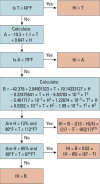Methods to calculate the heat index as an exposure metric in environmental health research
- PMID: 23934704
- PMCID: PMC3801457
- DOI: 10.1289/ehp.1206273
Methods to calculate the heat index as an exposure metric in environmental health research
Abstract
Background: Environmental health research employs a variety of metrics to measure heat exposure, both to directly study the health effects of outdoor temperature and to control for temperature in studies of other environmental exposures, including air pollution. To measure heat exposure, environmental health studies often use heat index, which incorporates both air temperature and moisture. However, the method of calculating heat index varies across environmental studies, which could mean that studies using different algorithms to calculate heat index may not be comparable.
Objective and methods: We investigated 21 separate heat index algorithms found in the literature to determine a) whether different algorithms generate heat index values that are consistent with the theoretical concepts of apparent temperature and b) whether different algorithms generate similar heat index values.
Results: Although environmental studies differ in how they calculate heat index values, most studies' heat index algorithms generate values consistent with apparent temperature. Additionally, most different algorithms generate closely correlated heat index values. However, a few algorithms are potentially problematic, especially in certain weather conditions (e.g., very low relative humidity, cold weather). To aid environmental health researchers, we have created open-source software in R to calculate the heat index using the U.S. National Weather Service's algorithm.
Conclusion: We identified 21 separate heat index algorithms used in environmental research. Our analysis demonstrated that methods to calculate heat index are inconsistent across studies. Careful choice of a heat index algorithm can help ensure reproducible and consistent environmental health research.
Conflict of interest statement
The authors declare they have no actual or potential competing financial interests.
Figures




References
-
- Ahrens CD. Belmont, CA: Brooks/Cole; 2007. Meteorology Today: An Introduction to Weather, Climate, and the Environment.
-
- Analitis A, Katsouyanni K, Biggeri A, Baccini M, Forsberg B, Bisanti L, et al. Effects of cold weather on mortality: results from 15 European cities within the PHEWE project. Am J Epidemiol. 2008;168(12):1397–1408. - PubMed
-
- Anderson GB, Peng RD. weathermetrics: Functions to convert between weather metrics (R package). 2012. Available: http://cran.r-project.org/web/packages/weathermetrics/index.html [accessed 18 July 2013]
Publication types
MeSH terms
Grants and funding
LinkOut - more resources
Full Text Sources
Other Literature Sources
Medical

